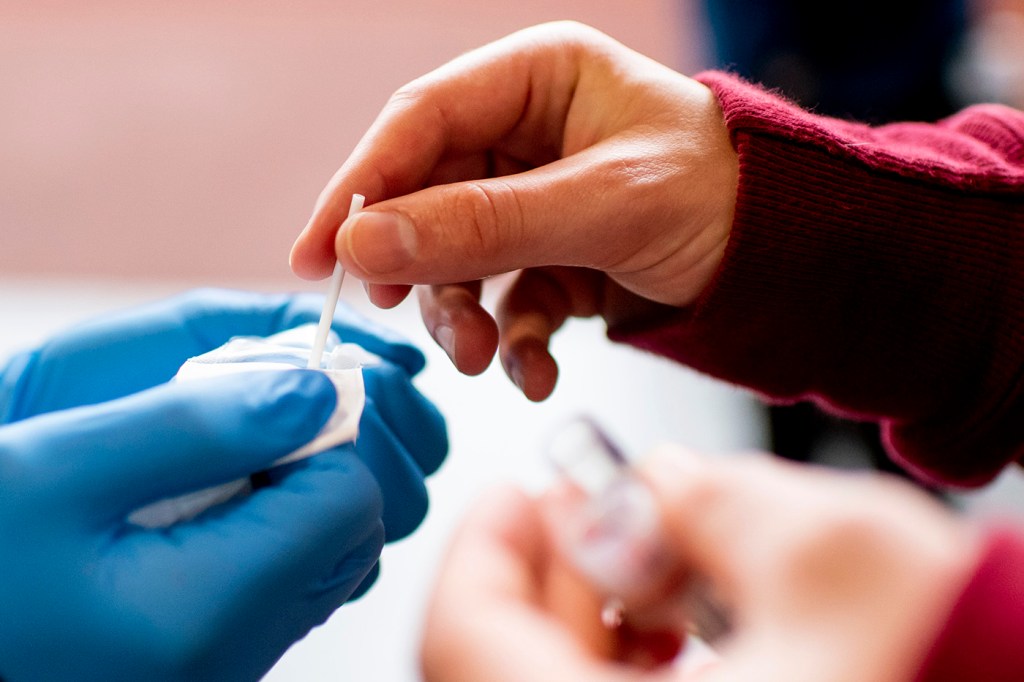Northeastern to increase coronavirus testing frequency when fall semester starts

In a move designed to promote safety on the Boston campus and in the surrounding communities, Northeastern University will begin testing students for COVID-19 every three days, and faculty, staff, and contract workers twice a week, in order to more quickly catch and isolate any positive cases before the coronavirus that causes the disease can spread. The new testing cadence is a step up from the current schedule for people who work and learn on the Boston campus.
“Right now, the campus is in a very good posture; during the first week of testing, we tested circa 6,000 people and had one positive case,” says David Luzzi, senior vice provost for research and vice president of Northeastern’s Innovation Campus, and head of the university’s testing operation.
The new testing cadence will coincide with the launch of an automatic test scheduling tool at the end of August that reminds users of their next testing day.
“The simple fact is, the more frequently we test, the better we’re able to maintain control of the situation on campus, and this is a situation where we would rather test more aggressively and be safe,” Luzzi says.
The university requires all people studying, living, and working on campus to be tested for the coronavirus.
Students must be tested the day they arrive, then on day three, followed by day five—and will be able to attend classes in person after receiving negative results on all three tests. After their three initial tests, students, with some exceptions, will be tested once every three days.
Faculty, staff, and contract workers who are on the Boston campus more than one day a week will now be tested twice a week, such as a rotating Monday/Thursday or Tuesday/Friday schedule.
Faculty, staff, and contract workers who are on campus once per week or less will be tested only when they’re on campus. People who work on campus less than five days per week but more than once a week will be tested any two days they’re on site.
As of Friday, Aug. 20, the university had completed 6,573 tests, with 6,572 negative results and one positive result.
An online dashboard is updated daily with the latest results from Northeastern’s Life Sciences Testing Center, a new, state-of-the-art laboratory on the university’s Innovation Campus in Burlington, Massachusetts, which this month secured state and federal certifications to process coronavirus samples.
“Our approach to testing has always been science-based and data-driven,” Luzzi says. “With more frequent testing, we’re able to capture a lot of data and that data will give us an exquisitely good view of what’s going on on campus. It will allow us to understand the facts on the ground faster and make adjustments accordingly.”
By screening everyone regularly and rapidly, Northeastern’s testing operation will be able to identify cases even before a person shows symptoms of being sick. The strategy—often called surveillance testing—will help ensure that people who are either asymptomatic or pre-symptomatic are tested and receive the care they need to prevent spreading the coronavirus to others.
Anyone experiencing symptoms of COVID-19 will need to consult with a medical provider to see if testing is needed, and if so, proceed to a different, specially designated facility that’s part of the Marino Recreation Center for symptomatic testing.
The move to more frequent testing for students, faculty, staff, and contract workers is also part of a strategy to determine “how you can effectively operate a campus in the presence of an endemic situation which is this virus,” Luzzi says.
Northeastern is already part of a team of research institutions that are creating models to advise the federal administration on the COVID-19 outbreak in the United States, and university officials have consulted regularly with its faculty in the field on how to safely open campus this fall.
“In addition to keeping our communities safe, we want the results of our testing program to feed this modeling capability so that coming out of this is a definitive understanding of how to run a campus safely and effectively in the presence of a pandemic,” Luzzi says.
The increased testing frequency will mean a larger number of samples for the Life Sciences Testing Center to process each day—an outcome it is fully prepared for, says Jared Auclair, associate teaching professor of biotechnology, who leads the testing center.
“At full capacity, the lab will be able to handle 5,000 tests per day,” he says. “The space is also very nimble—we can flex into additional space to increase our capacity if we need to. I feel very confident that we’re doing what needs to be done to keep campus safe—we’re nimble and flexible enough to adapt as things change.”
Roberto Molar Candanosa contributed to this report.
For media inquiries, please contact media@northeastern.edu.




